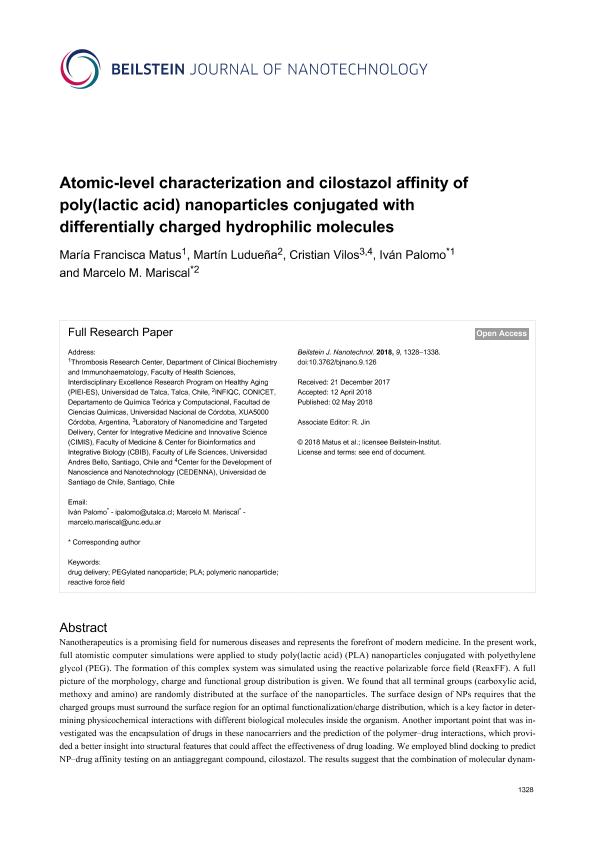Mostrar el registro sencillo del ítem
dc.contributor.author
Matus, María Francisca
dc.contributor.author
Ludueña, Martin

dc.contributor.author
Vilos, Cristian
dc.contributor.author
Palomo, Iván
dc.contributor.author
Mariscal, Marcelo

dc.date.available
2019-10-08T13:20:27Z
dc.date.issued
2018-05
dc.identifier.citation
Matus, María Francisca; Ludueña, Martin; Vilos, Cristian; Palomo, Iván; Mariscal, Marcelo; Atomic-level characterization and cilostazol affinity of poly(lactic acid) nanoparticles conjugated with differentially charged hydrophilic molecules; Beilstein-Institut Zur Forderung der Chemischen Wissenschaften; Beilstein Journal of Nanotechnology; 9; 1; 5-2018; 1328-1338
dc.identifier.issn
2190-4286
dc.identifier.uri
http://hdl.handle.net/11336/85322
dc.description.abstract
Nanotherapeutics is a promising field for numerous diseases and represents the forefront of modern medicine. In the present work, full atomistic computer simulations were applied to study poly(lactic acid) (PLA) nanoparticles conjugated with polyethylene glycol (PEG). The formation of this complex system was simulated using the reactive polarizable force field (ReaxFF). A full picture of the morphology, charge and functional group distribution is given. We found that all terminal groups (carboxylic acid, methoxy and amino) are randomly distributed at the surface of the nanoparticles. The surface design of NPs requires that the charged groups must surround the surface region for an optimal functionalization/charge distribution, which is a key factor in determining physicochemical interactions with different biological molecules inside the organism. Another important point that was investigated was the encapsulation of drugs in these nanocarriers and the prediction of the polymer-drug interactions, which provided a better insight into structural features that could affect the effectiveness of drug loading. We employed blind docking to predict NP-drug affinity testing on an antiaggregant compound, cilostazol. The results suggest that the combination of molecular dynam ics ReaxFF simulations and blind docking techniques can be used as an explorative tool prior to experiments, which is useful for rational design of new drug delivery systems.
dc.format
application/pdf
dc.language.iso
eng
dc.publisher
Beilstein-Institut Zur Forderung der Chemischen Wissenschaften
dc.rights
info:eu-repo/semantics/openAccess
dc.rights.uri
https://creativecommons.org/licenses/by-nc-sa/2.5/ar/
dc.subject
DRUG DELIVERY
dc.subject
PEGYLATED NANOPARTICLE
dc.subject
PLA
dc.subject
POLYMERIC NANOPARTICLE
dc.subject
REACTIVE FORCE FIELD
dc.subject.classification
Nano-materiales

dc.subject.classification
Nanotecnología

dc.subject.classification
INGENIERÍAS Y TECNOLOGÍAS

dc.title
Atomic-level characterization and cilostazol affinity of poly(lactic acid) nanoparticles conjugated with differentially charged hydrophilic molecules
dc.type
info:eu-repo/semantics/article
dc.type
info:ar-repo/semantics/artículo
dc.type
info:eu-repo/semantics/publishedVersion
dc.date.updated
2019-09-30T18:50:02Z
dc.identifier.eissn
2190-4286
dc.journal.volume
9
dc.journal.number
1
dc.journal.pagination
1328-1338
dc.journal.pais
Alemania

dc.description.fil
Fil: Matus, María Francisca. Universidad de Talca; Chile
dc.description.fil
Fil: Ludueña, Martin. Consejo Nacional de Investigaciones Científicas y Técnicas. Centro Científico Tecnológico Conicet - Córdoba. Instituto de Investigaciones en Físico-química de Córdoba. Universidad Nacional de Córdoba. Facultad de Ciencias Químicas. Instituto de Investigaciones en Físico-química de Córdoba; Argentina
dc.description.fil
Fil: Vilos, Cristian. Universidad Andrés Bello; Chile
dc.description.fil
Fil: Palomo, Iván. Universidad de Talca; Chile
dc.description.fil
Fil: Mariscal, Marcelo. Universidad Nacional de Córdoba. Facultad de Cs.químicas. Departamento de Química Teórica y Computacional; Argentina. Consejo Nacional de Investigaciones Científicas y Técnicas. Centro Científico Tecnológico Conicet - Córdoba. Instituto de Investigaciones en Físico-química de Córdoba. Universidad Nacional de Córdoba. Facultad de Ciencias Químicas. Instituto de Investigaciones en Físico-química de Córdoba; Argentina
dc.journal.title
Beilstein Journal of Nanotechnology
dc.relation.alternativeid
info:eu-repo/semantics/altIdentifier/url/https://www.beilstein-journals.org/bjnano/articles/9/126
dc.relation.alternativeid
info:eu-repo/semantics/altIdentifier/doi/http://dx.doi.org/10.3762/bjnano.9.126
Archivos asociados
